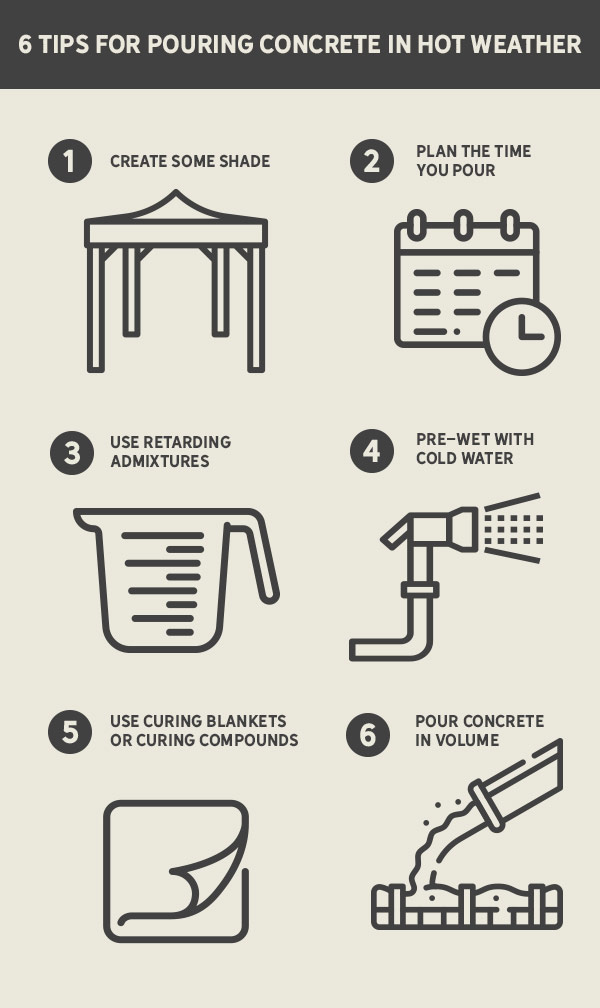

Is it Too Hot? Pouring Concrete in Hot Weather
Planning concrete pours involves a ton of factors, including the preparation of the site, scheduling the concrete delivery, but also checking the weather forecast. Temps that are too hot (or too cold) can affect all aspects of concrete pouring from the first minutes of curing to the longevity of the slab. Brush up on how temperature affects concrete, and how to plan for anything that Mother Nature might throw your way.
How Temperature Affects Concrete
Concrete is a go-to material to create a beautiful new driveway, sidewalk, patio, parking pad, or even support a new mailbox. But before you get to mixing your materials, take a good long look at your local weather forecast. You may want to hit the pause button or make certain alternative concessions to ensure a quality concrete pour, if it’s going to be hot out.
Made up of cement, sand, aggregate, and water to make a liquid form that’s pourable, concrete begins a chemical reaction water among its components once it stops moving and begins to “cure.” Like paint drying on a wall, the air temperature and relative humidity can affect the rate of concrete curing. The ideal temperature range for pouring concrete is 50°F to 60°F — but don’t sweat that fact. You can still run a concrete business in our neck of the woods where we rarely see temps that cool.
Keep in mind you may need to make some plans if your temperatures swing up and down:
- When pouring concrete in hot weather, you can see too little moisture in the mix because the water will evaporate too quickly. The final concrete will still harden, but tends to crack, flake, chip, and not be as strong as concrete poured in ideal conditions.
- Alternatively, concrete poured when temperatures are too cold can result in slow curing, which can lead to the concrete shifting over time. If conditions are below freezing, the water in the concrete mix can expand, and could lead to a weak concrete slab that could collapse under weight.
While temperature is one of the most important factors when choosing to pour concrete, you should also consider weather conditions. Even light rain can damage freshly poured concrete (while alternately, a repeated light misting in hot weather conditions can help concrete cure evenly).
After a few hours (four to eight approximately), a little rain will help the concrete cure. Avoid pouring concrete when the weather is especially unpredictable, such as when high winds are forecast because debris could land in your wet mix, or evaporation could increase.
When is the Best Time to Pour Concrete
You’ll want to plan to pour early or late, especially if you’re working in the summertime or during a heat wave. Ideal temperatures of 50°F to 60°F might pass by in the blink of an eye when it’s especially hot out. Plan pours well before 10am or after 8pm when the heat has dissipated.


6 Tips for Pouring Concrete in Poor Conditions
- Create some shade. If you are lucky enough to be pouring in a shady spot, you could gain some cool minutes. But if you aren’t so lucky, you can create shade over your area with a large, suspended tarp or tent.
- Plan the time you pour. The best time to pour is early in the morning, or late in the day. Especially when the sun rises early – like the summer months – you’ll want to get started as early as you can to take advantage of the coolest temperatures, or squeeze in a pour at the end of the day.
- Use retarding admixtures. Especially helpful in hot weather, admixtures are added to the concrete immediately before or during mixing. Retarding admixtures counteract the rapid evaporation brought on by high temperatures. They keep the concrete pliable longer so you can get it moved into place and smoothed out.
- Pre-wet with cold water. Instead of pouring concrete onto dry ground, a good practice in especially hot and dry conditions is to pre-wet the surface with cold water. This ensures that the concrete’s curing process will start immediately when it hits the moistened ground and will help prevent cracking.
- Use curing blankets or curing compounds. A curing compound is sprayed onto newly poured concrete to form a barrier that prevents water from evaporating too quickly. The compounds either dissolve by design or need to be scrubbed off after a few weeks. Curing blankets are wet, moisture-retaining fabric that work to keep the rate of evaporation slow enough to ensure even curing.
- Pour concrete in volume. Make sure that the depth of your concrete pour is a minimum of four inches for most standard concrete projects and at least six inches thick on projects that will see heavy traffic.
Let McCoy’s Help You Get All Set Up
Concrete pouring shouldn’t be too hard. (Wait, maybe it should?) What we mean is that McCoy’s is here to help you keep your cool – even if the temperature isn’t. We open at 7am to outfit your jobsite before it heats up, and we can help get you in, out, and on your way fast with online shopping or set up delivery! No matter what, our friendly employees are always here to help your next project go…smoothly.
